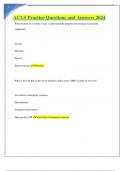Lecture 20 – Exam Revision 03
Propositional Logic
1. Definition and Purpose
o Propositional Logic is used to establish the validity of arguments,
providing rules that allow us to judge whether an argument is sound
or unsound. This helps determine whether a conclusion drawn from
stated premises is valid.
2. Propositions
o A proposition is a statement that is either true or false.
o Examples:
6 < 24 (True)
3 + 2 = 4 (False)
"Tomorrow is my birthday" (Context-dependent truth value)
3. Non-Propositional Statements
o Statements like questions and exclamations are not propositions as
they do not equate to true or false.
o Examples:
"Keep off the grass!" (Exclamation)
"What time is it?" (Question)
Compound Propositions and Connectives
1. Negation
o The negation of a proposition reverses its truth value. If p is true,
then ¬p (not p) is false, and vice versa.
o Example:
If p = "It is raining," then ¬p = "It is not raining."
, 2. Conjunction (AND)
o The conjunction of two propositions p and q is true only when both p
and q are true.
o Example:
p: The sun is shining.
q: I am learning logic.
p ˄ q: The sun is shining AND I am learning logic.
3. Disjunction (OR)
o The disjunction of two propositions p and q is true if at least one of
them is true.
o Inclusive OR (˅): Either or both propositions can be true.
o Exclusive OR (XOR): Exactly one but not both propositions are
true.
4. Implication (Conditional)
o Implication: p → q (If p, then q). This is false only when p is true,
and q is false.
o Example:
p: I eat breakfast.
q: I don’t eat lunch.
p → q: If I eat breakfast, then I don’t eat lunch.
5. Bi-conditional
o Bi-conditional: p ↔ q (p if and only if q). This is true when both
propositions have the same truth value.
o Example:
p: I eat breakfast.
q: I don’t eat lunch.
p ↔ q: I eat breakfast if and only if I don’t eat lunch.







